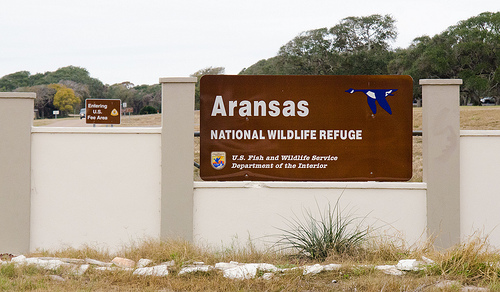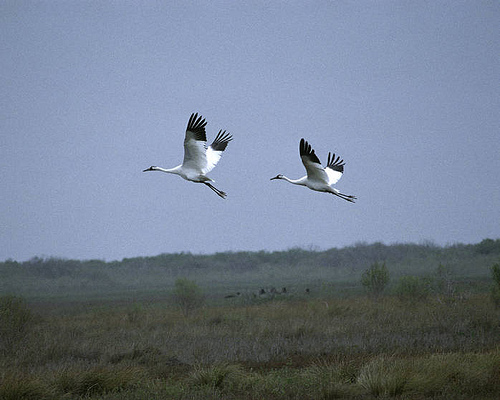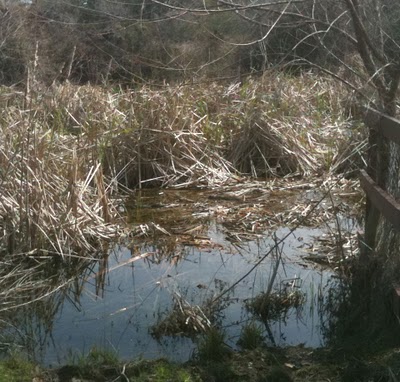During our stays at Goose Island State Park outside Rockport, TX, we always try to make a visit to Aransas National Wildlife Area which is about a 35 mile drive. Aransas NWA is famous as the winter home of Whooping Cranes (although we have had much better luck near Goose Island State Park, on 8th avenue near the Big Tree where there are feeders in several pastures). Aransas is just a wonderful place to visit for birds and wildlife.
I remember our first visit: it was tension-filled because I had headed out with probably a half-tank of gas in the truck and you know how that goes – the second half seems to go a lot faster than the first. It is a Texas-flat drive. I don’t think we changed elevation more than ten feet the whole way – that to cross streams – and most of it was straight as an arrow. Massive black dirt field lie in wait of spring planting — and way across them, you could see cars and trucks moving like mirages. We cut that trip a bit short due to the gas situation — there’s nothing out there.
The roads in from Highway 35 are narrow farm roads and the signage is a little weak, at least the first time you drive it. It’s a lot further in than an Easterner might expect – it seems to go on forever — like much of Texas driving. As mentioned, there are very few gas stations or places to eat nearby, so plan accordingly. The Visitor Center (pay here for admission to the park–$5/car) is very nice with exhibits, a short film, gift shop and restrooms. We found the volunteers really friendly and helpful – like many federal parks and areas, the volunteer help makes the operations run.

Ringed by tidal marshes and broken by long, narrow sloughs, this 59,000-acres refuge sprawls mostly across the Blackjack peninsula.
Mild winters, plentiful water, and an abundant food supply attract more than 400 species of birds throughout the year. While the Whooping Crane is undoubtedly the highlight of the winter months, other water birds including Reddish Egret, White and White-faced Ibis, Mottled Duck, and Purple Gallinule also feed in the rich bay and the fresh-water lagoons further inland. In migration, the oak woods provide critical habitat for neotropical migrants traveling the Central Flyway. The sandy prairies and scrublands are hunting grounds for White-tailed Hawk, Crested Caracara, Aplomado Falcon, and other raptors. Rare treats like Buff-bellied Hummingbird, Masked Duck, Painted Redstart, and other surprise visitors from southern climes are always a possibility.

Whooping Cranes are one of the attractions but they are often far out and require a spotting scope. Many birders take boat tours out of Rockport for better looks.
Take the 16 mile driving loop, stop at overlooks and observation towers, plan several hours at least, and you will likely see deer, javelinas, raccoons, even alligators.

There is a alligator-viewing pool just outside the visitor center. There are several, just partially surfaced, here in this shot I took during a visit.
Unfortunately, the drought of the last several years has really affected the wildlife. Changing salinity levels have dropped the population of blue crabs, a primary food source for Whoopers, and some special feed has had to be trucked in during difficult periods. So you never know what you’ll see — but our visits in the last few years have been disappointing.
Most birders don’t make the NWA a destination per se — they are in the area for many of the other rich birding sites all along the coast and weave a trip here into their itinerary. Check locally — last time we were there, their was a reliable Burrowing Owl not far from the turn of the main highway and also several Scissor-tailed Flycatchers on fences just to the north of the area. Give it a shot — take your bike for some nice level riding with little traffic — just make sure you can out-pedal a javelina.
How to get there
From the south: Follow Hwy. 35N to the FM 774 exit. Turn right on FM 774 and go approx. 6 miles, winding through the farm fields. Turn right again on FM 2040. Go another 6 miles to the Refuge gate. Go to the Visitor Center to register.
From the north: Travel south on Hwy. 35 to Tivoli. Continue past Tivoli for approx. 1 mile to the FM 239 exit (on your left). Follow FM 239 to Austwell. Upon entering Austwell, FM 239 turns into FM 774 at the curve. Continue on FM 774. Follow 774 & take a right at the stop sign. Go down the end of the street. Take a right again. As you exit Austwell, drive ½ mile to the FM 2040 intersection. Go left on FM 2040 for about 6 miles to the Refuge gate. Go to the Visitor Center to register.

I enjoy your blog (I’m a Vermont beginning birder), and I saw this one on Aransas. I work for the National Wildlife Refuge Association – we partner with the refuge system to help advocate for funding and also promote wildlife refuges. Anyway, I was just down near there at Laguna Atascosa and Santa Ana. I’m guessing you’re familiar with them, but if not, they are also great places to go birding – and if you’re super lucky, spot an ocelot! Happy birding!